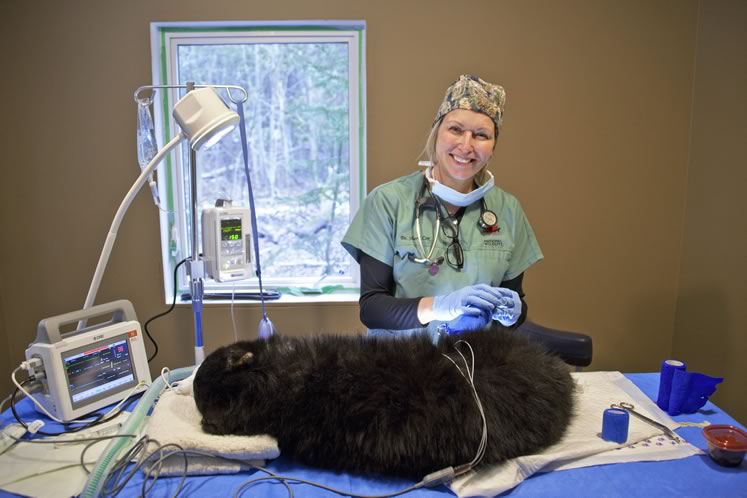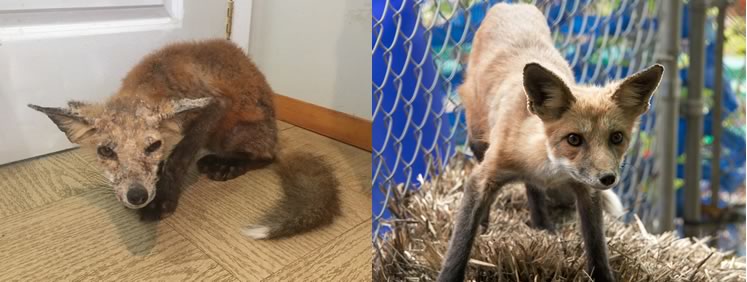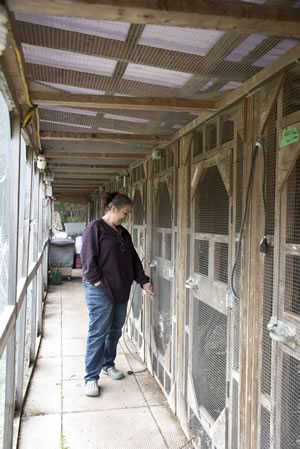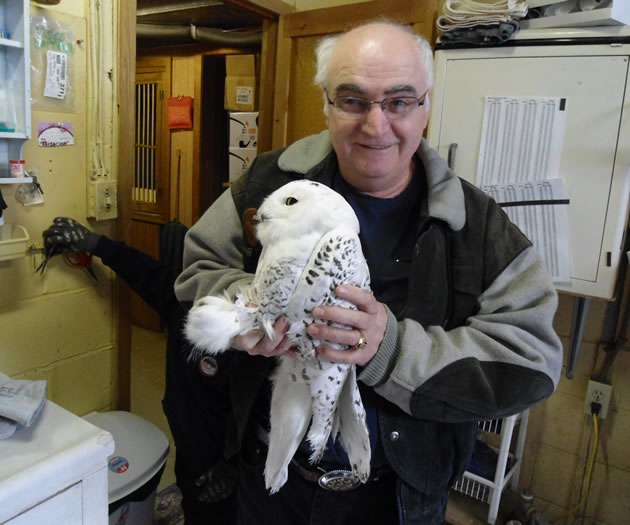Wildlife Rescue: Cry of the Wild
Sherri Cox, a corporate executive turned wildlife vet, takes her surgical skills on the road to aid animals in distress.
About the size of a Newfoundland dog, the bear cub lay unconscious on the operating table, breathing into a nose cone administering an anesthetic. Her coarse coat was black and thick, almost hiding the puncture wound in her side. The report said she was unable to use her back legs. Possible spinal trauma?
The police constable who had been alerted to the cub’s nighttime mishap called Shades of Hope Wildlife Refuge in Pefferlaw near Lake Simcoe and directed their volunteers to the injured cub in a watery roadside ditch.
Volunteers picked up the cub and called veterinarian Sherri Cox at her home in Caledon. Sherri asked that the animal be weighed, advised them on the amount of pain medication to administer, and the next morning got behind the wheel of her van to make the hour-plus drive to Pefferlaw.
The compact operating room at Shades of Hope was jammed with shelves and drawers overflowing with bandages and other medical equipment. Stethoscopes were draped over a wheeled IV caddy, canisters of oxygen were lined up at the ready, and there was a computer screen for viewing X-rays.
A portable X-ray machine was rigged up on a clothesline above the operating table, and a swing-arm spot lamp illuminated the cub.
Sherri performed the exploratory examination, describing to Trinita Barboza what her fingers were discovering. A graduate veterinarian, Trinita was approaching the halfway point of a one-year internship with Sherri. As Sherri worked, volunteer Erin Longo manipulated the dials attached to the nose cone to keep the cub sedated. The bear’s vital signs were periodically checked with a stethoscope. The regular ping of the pulse oximeter meant all was well.
Taking a keen interest in the patient, Cathy Stockman, director of operations at Shades of Hope, was in and out of the OR while she triaged the list of injured wildlife being readied for their turn on the operating table.
Along with the bear cub that day, Sherri would tend to a peregrine falcon, two gulls, a great blue heron, two porcupines, two osprey, a fox, a pigeon, a rabbit, an owl and a red-tailed hawk, as well as oversee a tail amputation on a squirrel.
She would take numerous X-rays, diagnose injuries, stabilize some, administer pain meds and antibiotics to others, discuss chart notes, insert a pin in a wing and suture a gash. Only after it was positively determined a patient would never be fit to return to the wild was the difficult decision made to euthanize.
In addition to the trauma that had paralyzed the bear cub’s rear legs, she had also suffered bruised lungs and a fractured front leg. Sherri put a cast on the broken leg, and the cub was later transported to Bear With Us Sanctuary and Rehabilitation Centre north of Huntsville. Unfortunately, the cub’s injuries proved to be so severe she didn’t survive.
The outlook is more hopeful for an orphaned yearling bear Sherri treated this spring. In January, an employee of a mining resource company discovered the young male sheltering in a metal culvert northwest of Dryden. Distressingly emaciated and severely frostbitten, the yearling was near death.

Sherri Cox prepares to perform surgery on a bear cub suffering from severe frostbite. Photo by Pete Paterson.
To get the bear the help he badly needed, “a lot of people went above and beyond the call of duty,” said Mike McIntosh, founder of Bear With Us. Mike’s “lot of people” included staff of the Ontario Ministry of Natural Resources and Forestry and the mining company, which paid for the yearling’s veterinary care in Dryden and his flight to North Bay where Mike picked him up.
At Bear With Us the yearling was treated with painkillers and antibiotics, and expertly and carefully reintroduced to food until he was strong enough to undergo surgery on the most severely frostbitten of his hind feet. Enter Sherri, who in early March amputated two of the toes on that foot.
Once the bear recovers, his ear will be tagged and he will be returned to the Dryden area for release.
Like other wildlife rehabilitators, Mike is effusive in his praise of Sherri’s work. “She’s amazing,” he said. “I’ve never met anybody with the abilities she has.”
Leaving the corporate world behind
Sherri has come a long way from the corporate world in which she began her career.
In 2002, while vice-president of a Fortune 500 corporation, Sherri spent her annual vacation volunteering in Galicia, Spain, where she helped assess the damage to the local seabird population after a major coastal oil spill. She returned to Canada traumatized by the devastation she had witnessed and with the firm conviction she had perched her career ladder against the wrong wall.
Trading in her power suit and leather briefcase for blue jeans and a canvas backpack, she went back to school with one goal: to develop the skills required to relieve suffering in Canadian wildlife. She had found her calling.
Becoming a wildlife veterinarian is no mean feat, and if you wait till you’re in your 30s to start the journey toward that goal, the odyssey is even more daunting. While continuing to hold down her executive position, Sherri hit the books for three years of intense studies in biology.
Then, saying farewell to corporate life, she completed a further four years of study at the University of Guelph’s Ontario Veterinary College. While at the OVC, Sherri completed wildlife-focused rotations at both Tufts University in Massachusetts and Cornell University in New York State. On top of this, she also finished a master of business administration.
She now volunteers her time at wildlife rehabilitation centres across Ontario, driving in her van, which is equipped as a mobile hospital (a gift from a special “angel donor”), and performing surgery on wild birds and animals.
In addition to working with Shades of Hope, Sherri also exercises her considerable skills at Procyon Wildlife Rehabilitation and Education Centre near Beeton, Bear With Us, Aspen Valley Wildlife Sanctuary in Rosseau, the Bluewater Centre for Raptor Rehabilitation near Sarnia, Sandy Pines Wildlife Centre in Napanee and Wildlife Haven, Waterloo.
She also uses Skype to share her knowledge with wildlife sanctuaries in Alberta and British Columbia, and travels every month to Seaforth, Nova Scotia, where she assists wildlife rehabilitator Hope Swinimer at Hope for Wildlife.
In 2014 Sherri founded the National Wildlife Centre with dreams of creating not only a centre of excellence for wildlife medicine and patient care, but also with a view to training others to help rehabilitate orphaned and injured wildlife.
Currently working on her doctoral thesis, Sherri is executive director of the Research Innovation Office at the University of Guelph and teaches a wildlife rehabilitation course to third- and fourth-year wildlife biology and conservation students.
A red-tailed hawk’s story
The little red-tailed hawk had already had a bad day when it was finally placed gently on the examining table in front of Sherri. It had been bundled into a box and driven by a volunteer the three and a half hours to Pefferlaw from Sarnia in the hope Sherri could do something for the beautiful creature. The Bluewater Centre for Raptor Rehabilitation, where the bird had been taken when it was found alive but unable to fly, had tracked Sherri that day to Pefferlaw.
The young bird had met misfortune while innocently perched on a chemical company’s flare stack searching for its next meal. The flare had been activated, and the hawk had suffered burns to both feet and major damage to its wing and tail feathers.
Sherri first checked the bird’s eyes, which looked good, then hooked him up to the anesthetic mask. He was intubated, treated for dehydration and lice, and given pain medication appropriate for his weight. On one foot, a toe had swollen to the size of an egg, and it was suggested the best option might be to remove it.
Sherri decided to cut away the dead tissue and try to save the digit with salves and frequent bandage changes rather than take the irrevocable step of amputation. To keep the damaged feet clean, booties were fashioned out of semi-stiff foam and attached to the bird’s feet with porous wrap.
Cathy Stockman offered to keep the bird at Shades of Hope for a few days of rehab and cage rest, and to keep Sherri updated. The hawk has since been returned to the Bluewater Centre where it spent the winter recuperating.
The bird’s feet are now fine, but the damage to its wing and tail feathers, necessary for flight, will keep it at Bluewater for several more months – until after it moults, probably in August. The badly singed feathers, said Lynn Eves, founder of Bluewater, will be replaced during the moulting process, so the bird should be ready for release this fall.
Perhaps by that time someone at the chemical company in Sarnia will have figured out that spikes installed on flare stacks or a warning whistle before the flaming gas is switched on could easily prevent such mishaps for birds.

Sox the fox arrived at Procyon Wildlife Centre sick and emaciated with mange. After six weeks of care, he was released sleek and healthy back to the wild. “These are the moments we strive for,” said Procyon director Sarah Bruce. Photo by Veronica Phillips.
Saving Sox the fox
Sox the fox was brought to Procyon Wildlife, the closest rehab centre to Headwaters, by compassionate residents who had been feeding him but watching his condition deteriorate. His fur was tattered and his eyes badly crusted. Mange was suspected.
Diagnosis confirmed, the volunteers at Procyon implemented a nutritional plan carefully designed to build up the fox’s strength and immune system, while keeping the food sources as natural as possible. “Unless you know what you are doing, feeding wild animals can actually weaken them and problems can snowball,” says Sarah Bruce, a director and animal care assistant at Procyon.

Procyon director Sarah Bruce. Photo by Pete Paterson.
After six weeks of daily care, Sox was looking spry, sleek and healthy. He was given rabies and distemper shots and driven to a release site near where he was first picked up. “He knows water and food sources in the area, and likely has a den nearby,” said Sarah. “He’s ready to discover the next chapter of his life. These are the moments we strive for.”
Wildlife rehab in Headwaters and beyond
Relying strictly on volunteers and donations from the public, wildlife rehabilitators must pass a provincial exam before being granted a custodial permit by the Ministry of Natural Resources and Forestry. Those who treat animals prone to spreading rabies, such as raccoons, skunks, bats and foxes, must also pass the Ontario rabies vector species exam. Familiarity with the Fish and Wildlife Conservation Act and the Endangered Species Act is mandatory.
The MNRF website currently lists more than 60 authorized wildlife rehabilitators, both individuals and organizations. And the number of animals finding their way to Ontario sanctuaries is astounding. About a thousand wild animals, for example, pass through Procyon’s doors every year, and Shades of Hope cared for about 3,600 orphaned or injured creatures in 2017. Multiply these figures by the number of rehab centres in the province, and the magnitude of the effort put forth by volunteers who spend their time alleviating wildlife suffering is awe-inspiring.
Though Sherri’s National Wildlife Centre is a registered charity, a bricks-and-mortar building in Headwaters is still in the formative stages. Sherri is actively pursuing the acquisition of property where she will be able to build a small surgery and create an environment where sick and orphaned wild animals will feel safe until they can eventually be released back into the wild.
“Always, the goal is to better serve the animals who find their way into our care,” said Sherri. “It takes a team of people with different skill sets to ensure the nutritional, reproductive, behavioural, migratory and general health status of an individual animal is taken into account each and every day he or she is in our care. We aren’t looking to create an empire, but rather a network of centres of excellence that will ensure the highest standard of care for the animals requiring our help.
“Domestic cats and dogs rely on their human family members when they get into trouble. The same isn’t true of wildlife.”
If you find a wild animal in need …
Except under specific circumstances, it is illegal in Ontario to keep a wild animal. According to the website of the Ontario Ministry of Natural Resources and Forestry, if you find a sick, injured or abandoned wild animal:
- Don’t immediately remove the animal from its natural habitat.
- Check the animal periodically for 24 to 48 hours. (According to Procyon Wildlife, most mother animals and birds will continue to accept their young even after they have been touched by humans. So placing a very young bird back in its nest, for example, is a good idea.)
- Keep your distance.
- Keep cats and dogs away, and limit noise (an adult animal may not return to its young if there is noise or if predators or people are close by).
- Contact a wildlife rehabilitator. For now, Procyon Wildlife Rehabilitation and Education Centre is the closest to Headwaters, at 6441 7th Line Beeton, 905-729-0033. The Procyon website includes detailed advice about what to do in various circumstances.
If you come across a sick or diseased wild animal and you suspect there is a public health risk, such as rabies or West Nile virus, contact your regional or local health unit immediately. If the animal is alive and there is a public safety threat, contact your local police department.
For more information about the National Wildlife Centre, go to www.nationalwildlifecentre.ca.
Related Stories

Snowy Owl Rescue
Mar 5, 2014 | | BlogsThe winter of 2013-14 has seen a “the largest movement of snowy owls in four or five decades” into southern Canada and the United States.








